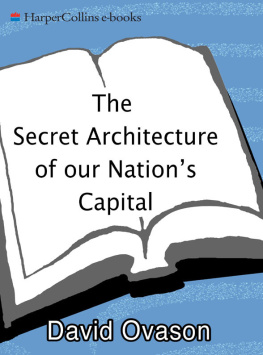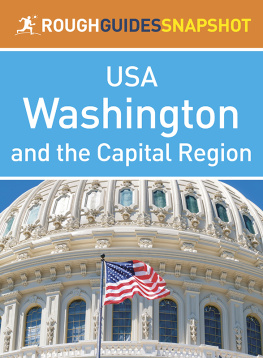FIELD GUIDE
TO THE
NATURAL
WORLD OF
WASHINGTON, D.C.


FIELD GUIDE
TO THE
NATURAL
WORLD OF
WASHINGTON, D.C.
Howard Youth
Illustrated byMARK A. KLINGLER
Photographs byROBERT E. MUMFORD, JR.
Maps byGEMMA RADKO
Foreword byKIRK JOHNSON

2014 Johns Hopkins University Press
All rights reserved. Published 2014
Printed in China on acid-free paper
9 8 7 6 5 4 3 2 1
Johns Hopkins University Press
2715 North Charles Street
Baltimore, Maryland 21218-4363
www.press.jhu.edu
Library of Congress Cataloging-in-Publication Data
Youth, Howard.
Field guide to the natural world of Washington, D.C. / Howard Youth ;
illustrated by Mark A. Klingler ; photographs by Robert E. Mumford, Jr. ;
maps by Gemma Radko ; with a foreword by Kirk Johnson
pages cm
Includes bibliographical references and index.
ISBN-13: 978-1-4214-1203-0 (hardcover: acid-free paper)
ISBN-10: 1-4214-1203-9 (hardcover: acid-free paper)
ISBN-13: 978-1-4214-1204-7 (paperback: acid-free paper)
ISBN-10: 1-4214-1204-7 (paperback: acid-free paper)
[etc.]
1. Natural historyWashington (D.C.)Guidebooks. 2. ParksWashington
(D.C.)Guidebooks. 3. Natural areasWashington (D.C.)Guidebooks.
4. Washington (D.C.)Guidebooks. I. Klingler, Mark A. II. Mumford, Robert E.,
1935. III. Title. IV Title: Field guide to the natural world of Washington, D.C.
QH105.W18Y68 2014
508.753dc23 2013015239
A catalog record for this book is available from the British Library.
All watercolor plates 2014 Mark A. Klingler
All photographs 2012 Robert E. Mumford, Jr., except , courtesy Wikimedia
All maps 2014 Gemma Radko
Special discounts are available for bulk purchases of this book. For more information, please contact Special Sales at 410-516-6936 or .
Johns Hopkins University Press uses environmentally friendly book materials,
including recycled text paper that is composed of at least 30
percent post-consumer waste, whenever possible.
Book design by Kimberly Glyder
CONTENTS
, BY KIRK JOHNSON
To my loving parents, my precious wife, and my wonderful children.
H.Y.

I would like to thank my wife, Cathy, for her constant support as I worked on the book, and my daughter, Olivia, for the impromptu drawing sessions. To my Mom and Dad, thank you for encouraging me in drawing and sculpting nature in the early years. I trust you both would be pleased. Also, my gratitude to all of my family and friends for their extensive knowledge and for finding critters for me to photograph and draw. Thank you, Howard, for photo references of locations in the parks and for the opportunity to share images of so many of D.C.s natural wonders with the public. Vincent J. Burke, thank you for your insights and for keeping me to deadlines so we could create this learning tool.
M.A.K.
FOREWORD
AFTER 30 YEARS OF COMING TO WASHINGTON, D.C., to visit the Smithsonians National Museum of Natural History (NMNH), last fall I became its director. With more than 7 million visitors and 127 million objects, NMNH is the largest and most visited nature and science museum in the world and, certainly, a required stop for any naturalist living in or traveling through the nations capital. Yet my 30 years of visiting Washington, D.C., revealed other places to see nature. I had brushing encounters with the Potomac River, Rock Creek Park, and the National Arboretum andeven while challenged on occasion by the swampy mugginess of the cityremained impressed with its profusion of lush green pockets. As I walked to the museum, I would often spot birds, bushes, or trees that were novel to my Denver-trained eyes. Now that I live here, and as the nations chief natural historian, I find myself in a need-to-know situation with respect to local nature.
Within weeks of arriving in Washington, I heard from my friend Mark Klingler, who was just completing the illustrations for a book about the natural history of my new home. Mark had teamed with author Howard Youth and photographer Robert Mumford, Jr., to create a neat and portable volume about the nature that exists in my new city. Using a combination of paintings, photographs, and prose, they tell tales of the citys parks and paths and do a great job of exploring and exposing the biodiversity that permeates the city. Located at the confluence of the Potomac and Anacostia Rivers at the head of Chesapeake Bay and just downstream from the Fall Line that marks the edge of the Appalachian Piedmont, Washington is a natural crossroad for migratory birds and a great place to experience the forests of the East Coast. The book describes the best locales to escape from sometimes frantic city life, places that provide opportunities for close encounters with nature.
Among the places highlighted in the book are D.C.s wetlands. People often say that Washington, D.C., used to be a swamp, as if that is a derogatory statement. Yet, as this book shows, Washington D.C.s swamps are some of the best locations to see amazing plants and animals. This book is a fantastic portal to them and to the rest of the natural world that surrounds and intertwines with our nations capital.
Kirk Johnson
Sant Director, Smithsonian National Museum of Natural History
ACKNOWLEDGMENTS
THIS BOOK IS A CELEBRATION OF NATURE in one of the countrys prettiest and most important cities. But here at the front, Id like to celebrate the many people who shared their knowledge and skills with me. Without them, I could not have written this book.
With artistic mastery, Mark A. Klingler breathed life into a staggering array of life-forms so you could see the wildlife I describe in the text. Rare is the artist who can capture the sophistication of a raccoon and the simplicity of an earthworm on an oak leaf. Thank you, Mark, for sharing your talents with us.
Two longtime friends and fellow nature enthusiasts made great contributions to this book.
Robert E. Mumford, Jr., took all of the books photos. Readers of this book will benefit from Bobs dogged wanderings and high photographic standards. He traveled around the city to make sure all plant and rock photographs were not only up to my standards but also his. Bob has created a stunning collection of photos of the parks and wildlife of D.C., many of which appear in his own book, Spring Comes to Washington. This field guide would not be the same without his contributions.
Robert E. Mumford, Jr., thanks the following people for helping to locate trees and shrubs to photograph: Gail Mackiernan, Mary Kay Smith, Barbara Knapp and Angela Butler of Butler Orchards.
Gemma Radko produced all of this books maps. She also put me in touch with important contacts, provided general information, and proofed my early draftsall this done after her daily work for the American Bird Conservancy. The maps provide visual orientation no words could capture and should make park visits much easier for readers. Thank you, Gemma, for all your work. You deserve a birding break!
Next page







